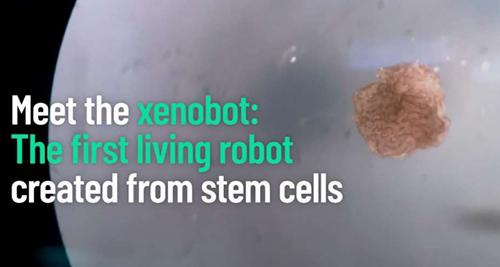Scientists create first ‘living robots’ in major breakthrough
Scientists have created what they claim are the first “living robots“: entirely new life-forms created out of living cells.
A team of researchers have taken cells from frog embryos and turned them into a machine that can be programmed to work as they wish.

It is the first time that humanity has been able to create “completely biological machines from the ground up”, the team behind the discovery write in a new paper.
That could allow them to dispatch the tiny “xenobots” to transport medicine around a patient’s body or clean up pollution from the oceans, for instance. They can also heal themselves if they are damaged, the scientists say.
“These are novel living machines,” says Joshua Bongard, the University of Vermont expert who co-led the new research. “They’re neither a traditional robot nor a known species of animal. It’s a new class of artifact: a living, programmable organism.”
The new creatures were designed using a supercomputer and then built by biologists. They could now be used for a variety of different purposes, those behind the creation say.
“We can imagine many useful applications of these living robots that other machines can’t do like searching out nasty compounds or radioactive contamination, gathering microplastic in the oceans, travelling in arteries to scrape out plaque,” said co-leader Michael Levin who directs the Center for Regenerative and Developmental Biology at Tufts University, where the xenobots were actually created.
The team described the major breakthrough in a paper published in the Proceedings of the National Academy of Sciences.
Humanity has been changing the way organisms work in some form for perhaps as long as it has been around. In recent years, there have been major leaps forward in that discipline, with genetic editing and the creation of artificial organisms.
But the researchers say that their work is the first time that a completely biological machine has been entirely designed and created by researchers.
They started to do so by using a supercomputer to create thousands of possible designs for the new life-forms. It did so through a virtual version of evolution, with scientists setting the computer a task and it calculating what design might work best.
If it was asked to create a being that moved in a certain direction, for instance, it would try out hundreds of different possible ways to combine simulated cells into different shapes that would allow the life-form to do so. It worked using rules about what the simple cells that would serve as the materials could do, and at the end gave scientists theoretical designs for the life-forms.
The second part of the research then saw a microsurgeon and other researchers turn those designs into real life. They took stem cells from the embryos of African frogs, incubated them, and then used incredibly tiny tools to cut them apart and assemble them into the design that the computer had created.
That meant that scientists had stuck real organic material together to create a life-form that had never been seen before in nature.
After that happened, the cells started to work together. Just as the computer had suggested, the robots were able to move on their own, eventually doing so in a coherent fashion and exploring their environment over a matter of weeks. They were able to work to push pellets around, organising themselves spontaneously and collectively, according to the researchers.
And scientists think they will be able to create even more complex versions of the xenobots. Computer simulations suggest that it should be possible to design the xenobots with a pouch on their body that could be used to carry an object – delivering a drug by swimming through the body, for instance.
Designing robots out of such living materials could lead to vast changes in the way that technology is used, the scientists suggest. The xenobots can regenerate, and are entirely biodegradable when they die.
What’s more, they are able to repair themselves. Unlike traditional materials, the robots can be sliced almost in half and will fix themselves back together again, they claim.
The researchers admit that there is the danger that such developments could be harnessed in ways that we don’t even understand, leading to unintended consequences. If the systems become sufficiently complex, it might be impossible for humans to predict how they will start to behave.
“If humanity is going to survive into the future, we need to better understand how complex properties, somehow, emerge from simple rules,” said Mr. Levin in a statement. “This study is a direct contribution to getting a handle on what people are afraid of, which is unintended consequences,” he said.
He said that the new study is an important step towards understanding such systems. By learning more about how living systems decide how they will behave, and whether and how that might be changed, we will be able to better understand their outcomes.
yogaesoteric
June 11, 2020
Also available in:
 Français
Français
